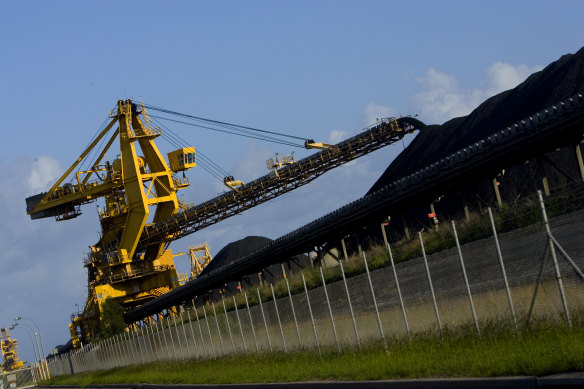The value of Australia’s coal and gas exports could be halved in just five years as new forecasts warn booming commodity prices have likely passed their peaks and key trading partners across Asia are increasing efforts to curb greenhouse gas emissions.
Federal government trade data, to be released on Monday, reveals earnings from Australia’s minerals and energy exports are set to reach unseen highs of $464 billion in 2022-23 after Russia’s invasion of Ukraine worsened a global energy crisis and boosted fossil fuel prices for a second straight year.
Prices for cargoes of thermal coal at the Port of Newcastle more than tripled in the past 12 months.Credit:Nic Walker
Record income from sales of Australian thermal coal – the type of coal burned in power stations – and metallurgical coal used in steel-making furnaces are expected to be $128 billion for the financial year, overtaking iron ore as the country’s most lucrative export.
Australia’s exports of liquified natural gas (LNG), meanwhile, are forecast to hit $91 billion in 2022–23, three times higher than in 2020–21, on the back of record-high prices as northern hemisphere nations scrambled to secure alternative supplies to Russian gas.
However, the figures from the Department of Industry, Science and Resources warn that the spectacular surge in energy commodity prices from 2022 has now “largely unwound” as the world economy slows and supply chain disruptions due to COVID-19 and weather show signs of easing.
“Australian resource and energy export earnings are thus set to fall noticeably,” the department says.
The benchmark price of high-quality thermal coal traded at the Port of Newcastle is expected to fall by up to 75 per cent by 2028 – from $US371 a tonne to $US90 a tonne. Global demand for thermal coal has passed its peak, the report says, while most proposed coal-fired power stations are being cancelled across the world.
The outlook for coal in Australia’s three biggest coal markets is also worsening as countries accelerate plans to combat climate change by reducing their use of the planet-heating fossil fuel and switching to cleaner sources of energy.
Taiwan’s coal imports fell 8 per cent in 2022 and plans to enlarge its coal-fired power fleet have been shelved. In South Korea, coal demand was steady last year, but is likely to come under pressure from the country’s accelerating use of gas, renewables and nuclear energy in coming years. Japan is planning for renewable energy to account for as much as 26 per cent of its power mix by 2030.
International gas markets are expected to remain tight and volatile until the end of 2024, largely because European nations are still seeking imports to make up for the lost supply that traditionally came via pipeline from Russia.
But new LNG facilities in the US and Qatar are set to crank up in 2025 to fill part of the gap.
The value of Australia’s overall coal exports is predicted to fall by $79 billion, from $128 billion to $49 billion, by 2028. LNG is expected to retreat by $44 billion, from $91 billion to $47 billion. This means Australia’s total fossil fuel export earnings could fall by more than $123 billion.
Resources Minister Madeleine King said Australia’s resources and energy exports continued to be “strikingly resilient”, and underlined the nation’s role as a stable and reliable supplier despite the global turmoil caused by Russia’s invasion of Ukraine.
She added that Australia’s exports of vital raw materials in clean-energy technologies, such as lithium, were growing strongly and on track to equal the value of coal shipments by 2027-28.
“Base metals and critical minerals such as lithium are crucial components of clean-energy technologies such as batteries, solar panels and wind turbines, which will help the world lower emissions and meet net-zero commitments,” King said.
The price of iron ore, the key steel-making raw ingredient, rebounded strongly in 2023 amid a recovery in Chinese steel production. Iron ore’s export earnings are forecast to be worth about $121 billion in 2022-23, down slightly from $132 billion a year earlier.
The trade figures show iron ore earnings falling to $98 billion in 2023-24 and to $75 billion by 2027-28.
However, the commodity has defied repeated past predictions that it is overdue for a period of prolonged weakness. At this time last year, iron ore was forecast to earn just $105 billion for this financial year.
The Business Briefing newsletter delivers major stories, exclusive coverage and expert opinion. Sign up to get it every weekday morning.
Most Viewed in Business
From our partners
Source: Read Full Article

